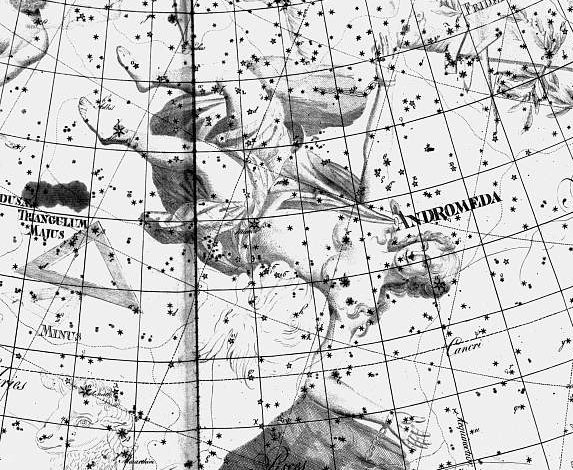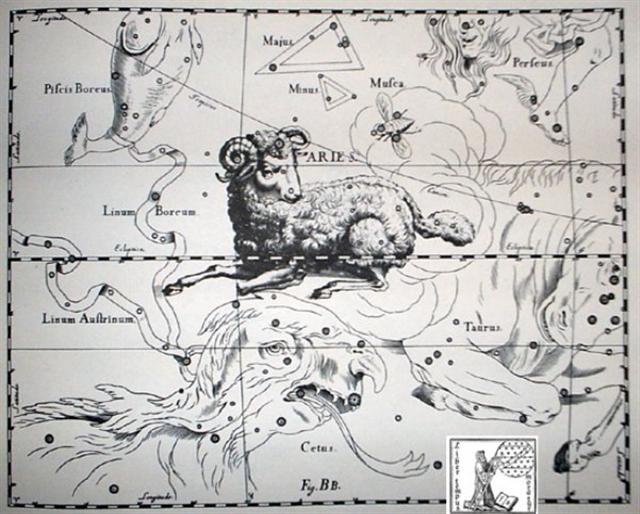313. So when the Explorers went to the cave Pu Pakakina A Ira (not A Hau Maka A Hiva) they probably were on their way to spring equinox at Libra:
When in the north the Sun was reaching the Train of the Garment of Andromeda (Adhil) the Full Moon was at the opposite side at the Girdle in Ursa Major (Mizar). But the Babylonians had named Spica the Girdle of Virgo (Sa-Sha-Shirū).
The Girdle of Andromeda (Mirach) was at FEBRUARY 1, which was 4 days earlier than Adhil and 4 + 183 = 187 days before Mizar (with Alcor and Spica) at Hora Iti 29 (*202.4 - *41.4). ... Proclus informs us that the fox star nibbles continuously at the thong of the yoke which holds together heaven and earth; German folklore adds that when the fox succeeds, the world will come to its end. This fox star is no other than Alcor, the small star g near zeta Ursae Majoris (in India Arundati, the common wife of the Seven Rishis, alpha-eta Ursae) ...
Or Hora Iti 29 (241) - Tehetu'upú 24 (340) = 365 + 241 - 340 = 266 (the day number corresponding to the September equinox + 1). From Hora Iti 29 to Bissextum there were 99 days. ... The leap day was introduced as part of the Julian reform. The day following the Terminalia (February 23) was doubled, forming the bis sextum - literally 'double sixth', since February 24 was 'the sixth day before the Kalends of March' using Roman inclusive counting (March 1 was the 'first day'). Although exceptions exist, the first day of the bis sextum (February 24) was usually regarded as the intercalated or 'bissextile' day since the third century. February 29 came to be regarded as the leap day when the Roman system of numbering days was replaced by sequential numbering in the late Middle Ages ... ... After five complete cycles totaling 2920 days, the movement of Venus fill eight idealized years of 365 days each and come within hours of spanning 99 lunations. (Popol Vuh) 8 * 365 = 5 * 584 = 2920 days, and 99 * 29.5 = 2920½. Thus 5 Venus cycles are joined to 8 Earth years in a way similar to how 7 'Sun flames' are joined to 6 'Moon flames'. JANUARY 31 (396) + (*64 - *41.4) = 418.6 or approximately 7 * 60 = 6 * 70. And 99 Moon cycles are also joined to 5 Venus cycles (and to 8 Earth years):
An essential feature of the Explorers' stay at the cave of Pu Pakakina A Ira - as if looking up in the night from the inside of the celestial sphere - was their repeatedly riding (like turtles) on the surf(ace) of the sea towards the western shore of Easter Island and thus illustrating the change from water to land, from the winter half of the year to the summer half. ... [E:32] Then Ira said, Let's go! Let's go down to swim with the board, to ride the waves! They all got up, climbed down, and arrived. They took off cape and loincloth (he huni e te hami). Then they all hurried and mounted the topside of a plank. They climbed on it, moved it, and reached the islets (motu, here, 'cliffs off the shore'). They all formed a line and looked towards the waves. When the wave began to rise, when it began to move faster and faster, they all turned the lower part of their body (? tiaeve) and coasted on top of the wave toward the right side. Once they were underway (literally, 'when the turtle was gone'), their eyes looked toward the land at an angle. Ira called out with a loud voice, Our ride on the wave is to the right! (Fast) as on a sled was the ride on the wave, and it brought them to the shore. The place where they landed was given the name Hanga Roa. They all turned around and went back (to the starting place out at sea). Then the ride on the waves went in the direction of the left side, and they landed in Apina Iti. [E:33] Again they all turned around and came back (to the starting point), and once again they rode in on the waves. They landed in Rio and gave the name Hanga O Rio. They went on land, sat down, stretched out, and dried in the sun. Then they all went back again and arrived (out there), and once again they all rode on the waves toward the beach. Again and again (they did it). They went on land, turned around, and climbed up together to the cave Pu Pakakina. There they stayed ... On the map of Métraux above we can locate the cape named Apina-iti just south of the bay Hanga-roa. If time was running from east to west - i.e. as if the sky features had been imprinted (in mirror fashion) down from above onto the surface of the earth - then the paws of Ku (Ketos, Cetus) would be at left when the rest of him would rise at the horizon in the east.
|
|||||||||||||||||||||||||||||||||||||||||||||||||||||||||||||||||||||||||||||||||||||||||||||||||||||||||||||||||||||||||||||||||||||||||||||||||||||||||||||||||||||||||||||||||||||||||||||||||||||||




.jpg)






